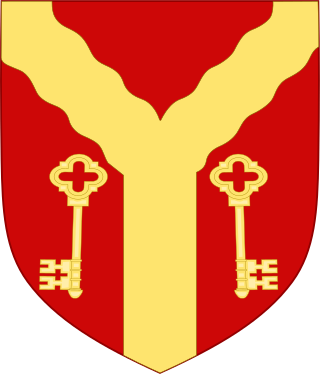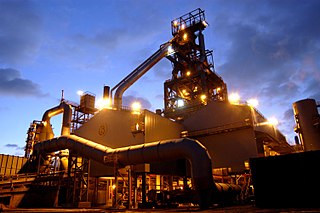This article needs additional citations for verification .(September 2022) |
Various science and technology sectors and organisations operate in Wales.
This article needs additional citations for verification .(September 2022) |
Various science and technology sectors and organisations operate in Wales.
The Wales Science and Innovation Advisory Council gives advice to the Chief Scientific Adviser for Wales on science, innovation and business policy for Wales but does not have any statutory or financial responsibilities. Members of the council include individuals involved in research and innovation, academics and those involved in industry. [1]
Health and Care Research Wales is a networked organisation, supported by Welsh Government, which brings together a wide range of partners across the NHS in Wales, universities and research institutions, local authorities, and others.
The organisations works in close partnership with other government agencies and research funders (both in Wales and across the UK); industry partners; patients; public and other stakeholders. Work together to promote research into diseases, treatments, services and outcomes that can lead to discoveries and innovations which can improve and even save people's lives. [5]
The Food Industry Centre (FIC) at Cardiff Metropolitan University (also known as UWIC) is a Welsh research and education organisation designed to address issues of food safety and food-related health concerns. Its mission also includes supporting the Welsh food industry. The centre, which is part of UWIC's Cardiff School of Health Sciences at the university's Llandaff campus, was launched in 1999. A new facility for the centre opened on 21 April 2009 and was built at a cost of £5,000,000. [6] [7]
The Aerospace Wales Forum is the trade association for companies that work in the Aerospace & Defence sector in Wales. [8]
Wales is an important[ how? ] producer of automotive components: Ford has a major engine plant at Bridgend,[ citation needed ] and BorgWarner has a major components plant in Kenfig, South Wales.[ citation needed ] However amid a global cost-cutting drive and citing a lack of demand for its manufacturing capacity, Ford closed the plant on 25 September 2020 and production of the Dragon engine is moving to Poland.[ citation needed ]
The Welsh Automotive Forum, also known as WAF, is a limited company that lobbies the government on behalf of the automotive industry in Wales. It was formed in 1999. [11]
TIMET has a plant in Waunarlwydd, Swansea, which is one of the world's major suppliers of titanium for jet engine blades and medical applications.[ citation needed ]
During the 1980s and 1990s, a major growth sector in manufacturing was the electronics industry with over 130 North American and 35 Japanese companies establishing operations in Wales.[ citation needed ] However, this is a characteristic of a "branch factory" economy where routine production is located in one region while higher skill activities are located in another.[ citation needed ]
The Centre for Alternative Technology (CAT) (Welsh : Canolfan y Dechnoleg Amgen) is an eco-centre in Powys, mid-Wales, dedicated to demonstrating and teaching sustainable development. CAT, despite its name, no longer concentrates its efforts exclusively on alternative technology, but provides information on all aspects of sustainable living.[ citation needed ]

Wrexham is a city and the administrative centre of Wrexham County Borough in Wales. It is located between the Welsh mountains and the lower Dee Valley, near the border with Cheshire in England. Historically in the county of Denbighshire, and later the county of Clwyd in 1974, it has been the principal settlement of Wrexham County Borough since 1996.

The University of Glamorgan was a university based in South Wales prior to the merger with University of Wales, Newport, that formed the University of South Wales in April 2013. The university was based in Pontypridd, in Rhondda Cynon Taf, with campuses in Trefforest, Glyntaff, Merthyr Tydfil, Tyn y Wern and Cardiff. The university had four faculties, and was the only university in Wales which had no link with the University of Wales.

Cooperative Research Centres (CRCs) are an Australian Federal Government program involved in Australian scientific research. The CRC programme is administered by the Commonwealth Department of Industry, Science and Resources, which provides funding for projects through a series of funding rounds.

Cardiff Metropolitan University, formerly the University of Wales Institute, Cardiff and commonly referred to as Cardiff Met, is a university located in the city of Cardiff.

The economy of Wales is part of the wider economy of the United Kingdom, and encompasses the production and consumption of goods, services and the supply of money in Wales.
Airbus UK is a wholly-owned subsidiary of Airbus, based in the United Kingdom, which produces wings for Airbus aircraft. When Airbus was incorporated as a joint-stock company in 2001, BAE Systems transferred the British facilities of the transnational Airbus Industrie GIE consortium formed in 1970 to the new corporation in exchange of a 20% stake in it. These facilities, together, formed the entity called EADS UK. In 2006, EADS ended up acquiring BAE's 20% minority stake; EADS UK thus became a wholly-owned subsidiary of the company. In 2015, EADS was rebranded "Airbus", and so were its divisions and many of its subsidiaries as a result, including EADS UK.

Broughton is a village in Flintshire, Wales, close to the Wales–England border, located to the west of the city of Chester, England, in the community of Broughton and Bretton. Along with the nearby village of Bretton, the total population was 5,791 at the 2001 Census, increasing to 5,974 at the 2011 Census.

Bengaluru, the capital city of the South Indian state of Karnataka, India. The economy of Bengaluru contributes over 43.65% to the economy of the State of Karnataka, accounting for 98% of the Software Exports of the State.

The economy of New South Wales represents a significant proportion of the Australian economy. The economy was valued at A$660.6 billion in 2021-22, representing 30.6% of Australia's total GDP.

The aerospace industry of the United Kingdom is the second-largest national aerospace industry in the world and the largest in Europe by turnover, with a global market share of 17% in 2019. In 2020, the industry employed 116,000 people.

The Cardiff School of Sport is a department of the Cardiff School of Sport and Health Sciences at Cardiff Metropolitan University, that provides sport, physical education and dance degrees in Cardiff, Wales. The school was originally established in c. 1949, however following the merger with the Cardiff School of Health Sciences in September 2017, it became part of the Cardiff School of Sport and Health Sciences.

The Food Industry Centre (FIC) at Cardiff Metropolitan University (also known as UWIC) is a Welsh research and education organisation designed to address issues of food safety and food-related health concerns. Its mission also includes supporting the Welsh food industry. The centre, which is part of UWIC's Cardiff School of Health Sciences at the university's Llandaff campus, was launched in 1999. A new facility for the centre opened on 21 April 2009 and was built at a cost of £5,000,000.
The United Kingdom, where the Industrial Revolution began in the late 18th century, has a long history of manufacturing, which contributed to Britain's early economic growth. During the second half of the 20th century, there was a steady decline in the importance of manufacturing and the economy of the United Kingdom shifted toward services. Manufacturing, however, remains important for overseas trade and accounted for 44% of goods exports in 2014. In June 2010, manufacturing in the United Kingdom accounted for 8.2% of the workforce and 12% of the country's national output. The East Midlands and West Midlands were the regions with the highest proportion of employees in manufacturing. London had the lowest at 2.8%.

Science and technology in the United Kingdom has a long history, producing many important figures and developments in the field. Major theorists from the United Kingdom of Great Britain and Northern Ireland include Isaac Newton whose laws of motion and illumination of gravity have been seen as a keystone of modern science and Charles Darwin whose theory of evolution by natural selection was fundamental to the development of modern biology. Major scientific discoveries include hydrogen by Henry Cavendish, penicillin by Alexander Fleming, and the structure of DNA, by Francis Crick and others. Major engineering projects and applications pursued by people from the United Kingdom include the steam locomotive developed by Richard Trevithick and Andrew Vivian, the jet engine by Frank Whittle and the World Wide Web by Tim Berners-Lee. The United Kingdom continues to play a major role in the development of science and technology and major technological sectors include the aerospace, motor and pharmaceutical industries.
Constellium SE is a Paris-based global manufacturer of aluminium rolled products, extruded products, and structural parts based on a large variety of advanced alloys. Constellium's C-TEC research center has been credited for advancing technology in the field of advanced aluminium alloy. Constellium primarily serves the aerospace, automotive, and packaging sectors. Large clients include Mercedes-Benz, Audi, BMW, Fiat Chrysler Automotive, Ford, Airbus, Boeing, and Bombardier.
Manchester Metropolitan University's Centre for Aviation, Transport and the Environment (CATE) is an international research centre based at the Dalton Research Institute specialising in the environmental impacts of the aviation industry.
Brexit and arrangements for science and technology refers to arrangements affecting scientific research, experimental development and innovation that are within the scope of the negotiations between the United Kingdom and the European Union on the terms of Britain's withdrawal from the European Union (EU).

Broughton railway station is a proposed railway station on the North Wales Coast line, situated north of Broughton, Flintshire, Wales. Recent proposals for the station use a site north of Airbus UK's West factory site and Hawarden Airport, where the B5129 crosses the North Wales Coast line. Older proposals for the station include using the old sites of the former Sandycroft and Saltney Ferry railway stations.

The manufacturing sector in Wales was historically centred on the mining industry, with slate, coal, tinplate and steel being important industries. Today, while traditional industries remain in smaller quantities, manufacturing in Wales is increasingly specialised and diverse, including parts of the automotive, aerospace, medical and technological industries.